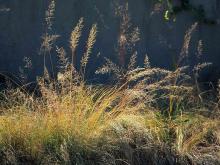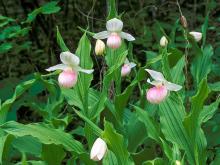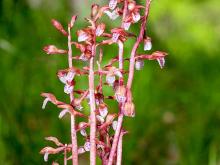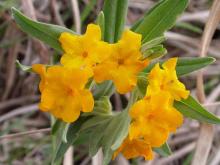Wildflowers, Grasses and Other Nonwoody Plants
Media

Species Types
Scientific Name
Sporobolus heterolepis
Description
Prairie dropseed is a native perennial bunch grass that forms dense clumps of fine, light green, arching leaves. The seed heads are airy, open, branching clusters bearing small, ovate florets on their own individual branchlets.
Media

Species Types
Scientific Name
Rumex crispus
Description
Curly dock’s rosettes of wavy-edged, leathery leaves are a common sight on roadsides and other disturbed lands. The fruit clusters at the top half of the plant turn dark rusty brown and are easy to spot from a distance.
Media

Species Types
Scientific Name
Helenium virginicum
Description
Virginia sneezeweed is the rarest of Missouri’s four sneezeweeds. A state endangered and federally threatened species, it occurs in about 60 sites in our southern Ozark counties, primarily in boggy, sinkhole pond habitats.
Media

Species Types
Scientific Name
Cypripedium reginae
Description
Showy lady’s slipper is a beautiful and rare wildflower. This orchid can be more than 3 feet tall, with showy flowers with a pink-suffused, inflated lower lip. In Missouri, it's restricted to the southern portion of the Ozarks.
Media

Species Types
Scientific Name
Galearis spectabilis (formerly Orchis spectabilis)
Description
Showy orchis is a perennial wildflower of rich, moist, shady woods, slopes, ravines, and stream valleys, often found with other spring wildflowers. It’s about 6 inches tall when it produces its beautiful pink and white flowers.
Media

Species Types
Scientific Name
Cypripedium candidum
Description
Of Missouri’s three species lady’s slipper orchids, small white lady’s slipper is the only one with white “slippers,” which are shiny and look almost like glazed porcelain. Today, it’s known from only one location in the Ozarks.
Media

Species Types
Scientific Name
Hexalectris spicata (syn. Bletia spicata)
Description
Crested coral root is an orchid that lacks chlorophyll, so none of it is green. It obtains nutrients from fungi and decaying organic matter. Compared to our other coral roots, it is taller and has larger flowers. It grows in Ozark habitats.
Media

Species Types
Scientific Name
Corallorhiza wisteriana
Description
Spring coral root blooms in April and May. Except for a few small sheathing bracts along the stem, it has no leaves. The purplish or brownish flowers are in a raceme at the tip of the stem. Each flower’s lower lip is white with purple markings.
Media

Species Types
Scientific Name
Calopogon tuberosus
Description
The tuberous grass pink is one of two species of grass pinks in Missouri. It lives in Ozark fens and is rare in the state. Like other orchids in genus Calopogon, its flowers seem upside down.
Media

Species Types
Scientific Name
Lithospermum canescens
Description
Hoary puccoon's small, tubular flowers arise on spirally condensed stalks that uncoil and elongate as more flowers open toward the tip. Occurs nearly statewide in prairies, glades, pastures, roadsides, and other open areas.
See Also
About Wildflowers, Grasses and Other Nonwoody Plants in Missouri
A very simple way of thinking about the green world is to divide the vascular plants into two groups: woody and nonwoody (or herbaceous). But this is an artificial division; many plant families include some species that are woody and some that are not. The diversity of nonwoody vascular plants is staggering! Think of all the ferns, grasses, sedges, lilies, peas, sunflowers, nightshades, milkweeds, mustards, mints, and mallows — weeds and wildflowers — and many more!





















